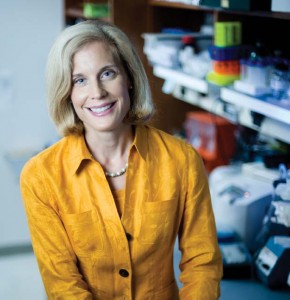Preventing Cancer
December 18, 2014

Photo by Joe Howell
When I was a postdoctoral fellow in the early 1990s, two large epidemiologic studies showed that a select group of human papilloma virus (HPV) types is responsible for premalignant lesions found in Pap smear screening and for the development of most cervical cancers. Later studies showed that nearly all cervical cancers are caused by HPV. At that time, research groups—including one led by Douglas Lowy, M.D., and John Schiller, Ph.D., at the National Cancer Institute (NCI)—started the work of developing a vaccine, which was finally approved by the FDA in 2006.
Although HPV vaccines have an excellent safety record, getting teenagers vaccinated has lagged in the United States. Frustratingly, less than one-third of American teenagers have had all three recommended doses of the vaccine today.
This vaccine has the potential to make an enormous difference in the number of people who develop cancer. Worldwide, more than 600,000 new cancer cases are caused by HPV every year. Cervical cancer is the most common, although the virus also plays a significant role in cancers of the vulva, vagina, anus, penis and oropharynx (throat).
If vaccination rates increased to 80 percent, the Centers for Disease Control and Prevention estimates that an additional 53,000 future cervical cancer cases would be prevented in the U.S. among girls who are now 12 years old or younger over the course of their lifetimes. In addition to cervical cancer, increased vaccination would have a measurable impact on the other 17,000 HPV-associated cancer diagnoses per year. A major portion of this is head and neck cancer, where approximately 70 percent of diagnoses are attributable to HPV infection.
Australia implemented a free, school-based HPV vaccination program in 2007, and studies show the country has already reached “herd immunity,” which occurs when the majority of a population is immunized and protects those who have not yet developed immunity or cannot be vaccinated. In Australia, genital warts diagnoses and cervical abnormalities have plummeted, and although it’s too soon to know about cancer rates (because the period from infection to cancer development is typically 20-30 years) researchers expect a similar decline.
No one should be dying from HPV-induced cervical or head and neck cancers 25-30 years from now. As a biomedical research community worldwide, we have invested in decades of research that led to the development of HPV vaccines, which prevent cancer. So why are HPV vaccination rates so low? Relevant barriers identified among health care providers, parents/caregivers and adolescents included missed clinical opportunities, misinformation, lack of knowledge, insufficient access or system gaps and cost concerns. With our NCI Comprehensive Cancer Center and strengths of a major health care system, Vanderbilt is working collaboratively with partners to address these barriers and change vaccine uptake. Be assured my son will be getting all three vaccinations at his annual pediatrician visit after he turns 11.
The HPV vaccine is just one arrow in our quiver aimed at preventing cancer. Cancer is an inevitable part of aging, so we will always provide cutting-edge, evidence-based treatment. However, we are more focused on cancer prevention and partnering with many community organizations, including the Tennessee Cancer Coalition, Progreso Community Center, Fisk Radio’s Health Watch and the Cumberland Pediatric Foundation to leverage resources and reach more people, especially underserved populations. We’re committed to getting the message out about how to prevent cancer.
Preventing cancer is not an elaborate algorithm. The recommendations are to quit smoking, eat a balanced diet, exercise, get vaccinated and stay out of the sun. A few lifestyle changes could make a major difference.
Sincerely,
Jennifer Pietenpol
